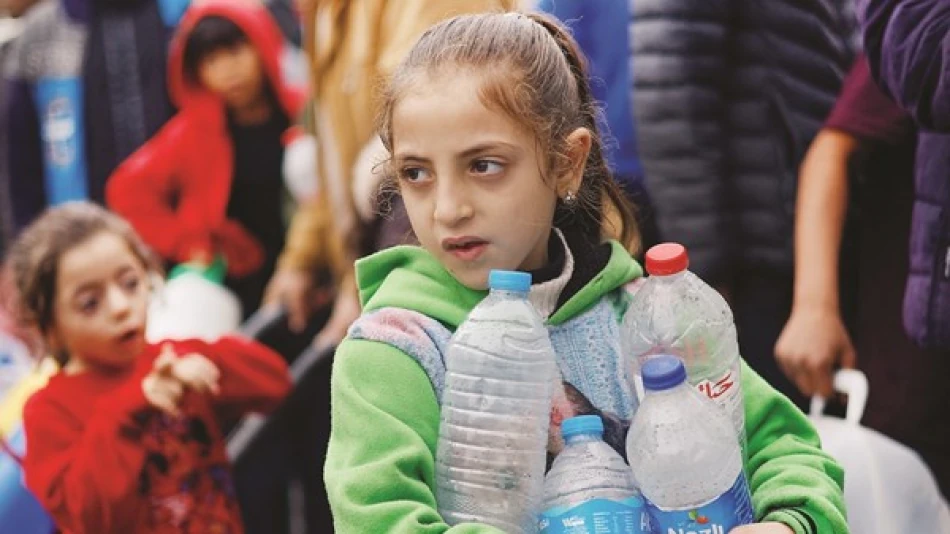
UNRWA: Scorching Heat and Water Scarcity Exacerbate Gaza's Humanitarian Crisis
Gaza's Water Crisis Reaches Breaking Point as Temperatures Soar Above 40°C
The humanitarian catastrophe in Gaza has entered a deadly new phase as soaring temperatures above 40°C (104°F) compound an already severe water shortage, creating conditions that threaten mass dehydration among the territory's 2.3 million residents. The UN agency for Palestinian refugees warns that ongoing bombardment, forced displacement, and infrastructure collapse have left the population with virtually no means to cope with the extreme heat.
A Perfect Storm of Crisis
The United Nations Relief and Works Agency for Palestine Refugees (UNRWA) reported yesterday that Gaza's water crisis has reached critical levels as the current heatwave intensifies suffering across the besieged territory. With limited electricity and fuel supplies, residents have no viable options for cooling relief, while the scarcity of available water dramatically increases dehydration risks.
The timing could not be worse. Gaza's summer temperatures regularly exceed 40°C, but this year's heatwave coincides with the most severe infrastructure damage the territory has ever experienced. Power grids, water treatment facilities, and distribution networks have been systematically degraded since the conflict escalated in October 2023.
Infrastructure Collapse Amplifies Natural Disaster
Water Systems Under Siege
Gaza's water infrastructure was already strained before the current conflict. The territory's aquifer has been over-pumped for decades, leading to saltwater intrusion that renders much of the groundwater undrinkable. Now, with treatment plants damaged and fuel shortages preventing pumping operations, the situation has become catastrophic.
UNRWA has been forced to rely on emergency measures, delivering bottled water and truck-transported supplies to approximately 1.7 million displaced persons. However, these stopgap solutions fall far short of meeting basic human needs during extreme heat conditions, where water requirements can triple.
The Electricity Factor
The collapse of Gaza's electrical grid has eliminated most cooling options for residents. Air conditioning, fans, and even basic refrigeration for water storage have become luxuries unavailable to the vast majority of the population. This creates a dangerous feedback loop where heat stress increases water needs precisely when water access is most restricted.
Historical Context: Gaza's Recurring Summer Crisis
This crisis follows a familiar but worsening pattern. Gaza has faced summer water shortages for over a decade, but previous years offered some mitigation through functioning infrastructure and international aid deliveries. The territory's population density of over 6,000 people per square kilometer—among the world's highest—has always made resource distribution challenging during peak demand periods.
The current situation represents an unprecedented convergence of factors: active conflict, infrastructure destruction, fuel embargos, and extreme weather. Unlike previous summers, when emergency water deliveries could reach most areas, large portions of Gaza remain inaccessible to aid operations.
International Response and Limitations
UNRWA's emergency water and sanitation programs have operated continuously since October 2023, but the agency faces severe operational constraints. Humanitarian corridors remain limited, fuel shortages affect distribution vehicles, and security concerns restrict movement of aid workers.
The agency's call for an immediate ceasefire reflects the reality that technical solutions cannot address a crisis of this magnitude while active hostilities continue. Water infrastructure requires sustained repair efforts, secure supply chains, and coordinated distribution networks—none of which can function effectively in an active conflict zone.
Public Health Implications
Medical experts warn that the combination of extreme heat, water scarcity, and overcrowded displacement conditions creates ideal circumstances for waterborne disease outbreaks. Dehydration weakens immune systems, while poor sanitation in temporary shelters increases transmission risks for cholera, dysentery, and other heat-sensitive pathogens.
Children and elderly residents face the highest risk, as their bodies regulate temperature less effectively and require more frequent hydration. With Gaza's healthcare system already overwhelmed, mass heat-related illness could push medical facilities beyond their breaking point.
Looking Forward: The Urgency of Immediate Action
The water crisis in Gaza represents more than a humanitarian emergency—it's a test case for international crisis response in conflict zones. The situation demonstrates how climate factors can rapidly transform already serious humanitarian crises into existential threats for entire populations.
Without immediate intervention, including ceasefire agreements that allow infrastructure repair and unrestricted humanitarian access, Gaza faces the prospect of a public health catastrophe that could persist long after current hostilities end. The territory's water systems, once damaged, require months or years to rebuild, meaning today's emergency could become tomorrow's permanent crisis.
Most Viewed News

 Layla Al Mansoori
Layla Al Mansoori






